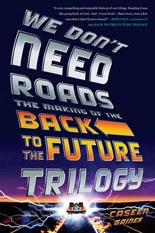
 I can think of a few people who may hate reading Caseen Gaines’ history of the Back to the Future trilogy. These people are Eric Stoltz (fired from the lead role of Marty McFly after filming began), Crispin Glover (more or less blackballed from the sequels), Jeffrey Weissman (Glover’s ill-treated replacement) and Cheryl Wheeler (a stuntwoman who nearly died during a questionably safe stunt in Part II).
I can think of a few people who may hate reading Caseen Gaines’ history of the Back to the Future trilogy. These people are Eric Stoltz (fired from the lead role of Marty McFly after filming began), Crispin Glover (more or less blackballed from the sequels), Jeffrey Weissman (Glover’s ill-treated replacement) and Cheryl Wheeler (a stuntwoman who nearly died during a questionably safe stunt in Part II).
Everyone else, go for it! While inessential in terms of claiming a cineaste’s shelf space, We Don’t Need Roads is a must-own for anyone with a deep fondness for the classic time-travel comedy, especially if you were among those audiences wowed upon its release in the summer of 1985. That’s the power of love.
Author of similar treatments on A Christmas Story and TV’s Pee-wee’s Playhouse, Gaines grants an insider’s view into the creation, production, impact and enduring legacy of the films, thanks to personal interviews with many key players. While Michael J. Fox, Thomas F. Wilson, Steven Spielberg and the aforementioned Glover are not among the dozens of participants, those who are can’t be considered lesser-ran slouches, including Christopher Lloyd, Lea Thompson, Huey Lewis and the two “Bobs”: producer Gale and director Zemeckis, both of whom wrote the Oscar-nominated screenplay — plenty of credibility.
Naturally, the first film takes up more space (as it should) than the consecutively shot sequels: 1989’s darker follow-up and 1990’s lighthearted Western. Readers get plenty of dished-up dirt on all, however. While presented chronologically, Gaines’ narrative finds him spending a bulk of each chapter focused on particular (and sometimes peculiar) aspect: Stoltz’s dismissal, the pimped-out DeLorean, the music of the Enchantment Under the Sea high school dance. It’s a unique way of approaching a behind-the-scenes tale, but if you don’t want an overload of info on, say, hoverboard technology, remember that patience is a virtue, and just settle back and enjoy the ride. So nontaxing and entertaining is We Don’t Need Roads that the Plume paperback can be read in virtually no time at all — and that’s even without a flux capacitor. —Rod Lott
